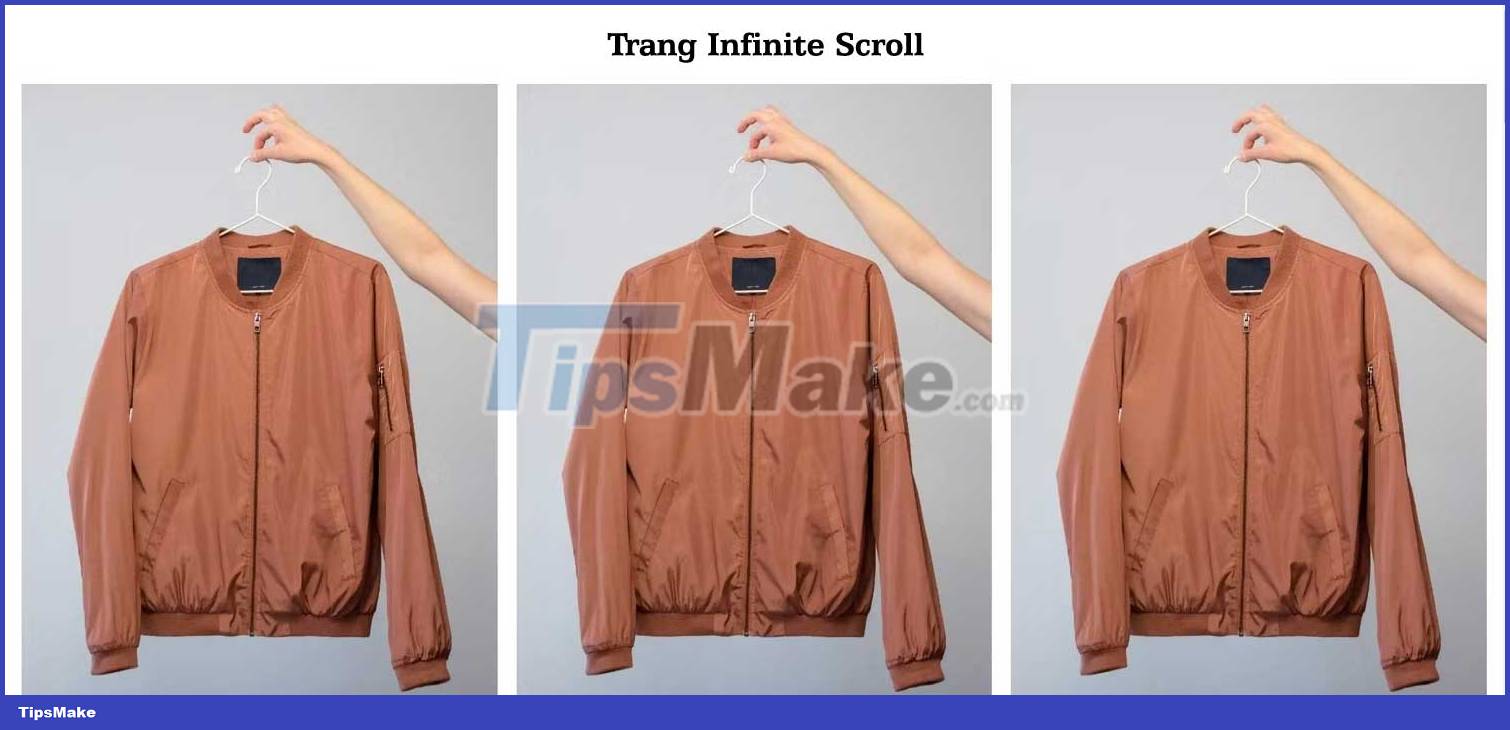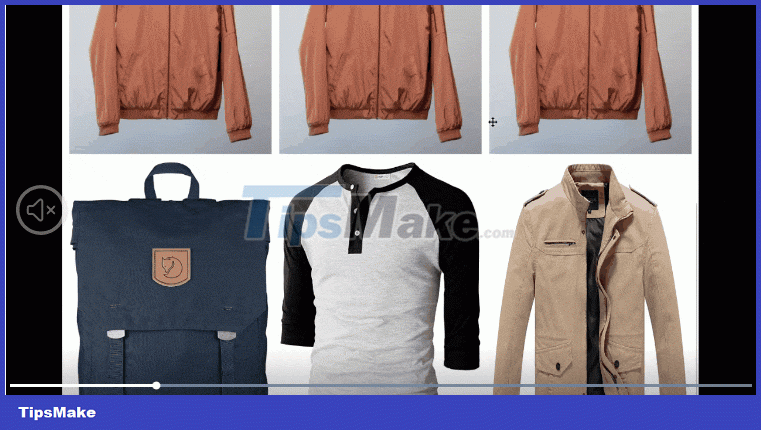How to implement Infinite Scroll in web application
Infinite scroll - Infinite scrolling allows content to load continuously as the user moves down the page, unlike the click-to-load method of traditional page alignment. This feature can provide a smoother experience, especially on mobile devices.

Let's explore with TipsMake how to set up simple Infinite scroll using HTML, CSS and JavaScript !
Set up the frontend
Start with basic HTML structure to display content. Here is an example:
Page scrolls infinitely






This page contains a string of placeholder images and references two sources: a CSS file and a JavaScript file.
CSS styles for scrollable content
To display the placeholder image in a grid, add the following CSS to the style.css file :
* { margin: 0; padding: 0; box-sizing: border-box; } html { font-size: 62.5%; } body { font-family: Cambria, Times, "Times New Roman", serif; } h1 { text-align: center; font-size: 5rem; padding: 2rem; } img { width: 100%; display: block; } .products__list { display: flex; flex-wrap: wrap; gap: 2rem; justify-content: center; } .products__list > * { width: calc(33% - 2rem); } .loading-indicator { display: none; position: absolute; bottom: 30px; left: 50%; background: #333; padding: 1rem 2rem; color: #fff; border-radius: 10px; transform: translateX(-50%); } Currently, your page will look like this:

Core implementation with JS
Edit script.js. To implement infinite scroll, you need to detect when the user has scrolled near the bottom of the container or content page.
"use strict"; window.addEventListener("scroll", () => { if ( window.scrollY + window.innerHeight >= document.documentElement.scrollHeight - 100 ) { // Người dùng ở gần dưới cùng, tìm nạp nhiều nội dung hơn fetchMoreContent(); } });Then create a function to fetch more placeholder data.
async function fetchMoreContent() { try { let response = await fetch("https://fakestoreapi.com/products?limit=3"); if (!response.ok) { throw new Error("Network response was not ok"); } let data = await response.json(); console.log(data); } catch (error) { console.error("There was a problem fetching new content:", error); } finally { console.log("Fetch function fired"); } } For this project, you can use the API from fakestoreapi .
To confirm data is fetched on scroll, look at the console:

You will see the data fetched multiple times as you scroll. It may be a factor affecting the performance of the device. To avoid this, create an initial data fetch state:
let isFetching = false;Then, edit the fetch function to only find data after a previously completed process.
async function fetchMoreContent() { if (isFetching) return; // Thoát nếu tìm nạp dữ liệu đã xong isFetching = true; // Đặt flag sang true try { let response = await fetch("https://fakestoreapi.com/products?limit=3"); if (!response.ok) { throw new Error("Network response was not ok"); } let data = await response.json(); } catch (error) { console.error("There was a problem fetching new content:", error); } finally { console.log("Fetch function fired"); isFetching = false; // Reset flag sang false } }Show new content
To show new content when the user scrolls down the page, create a function that appends the images to the main container.
First, choose the main component:
const productsList = document.querySelector(".products__list");Then create a function that appends content:
function displayNewContent(data) { data.forEach((item) => { const imgElement = document.createElement("img"); imgElement.src = item.image; imgElement.alt = item.title; productsList.appendChild(imgElement); // Append to productsList container }); } Finally, edit the fetch function and pass the fetched data to the append function.
async function fetchMoreContent() { if (isFetching) return; isFetching = true; try { let response = await fetch("https://fakestoreapi.com/products?limit=3"); if (!response.ok) { throw new Error("Network response was not ok"); } let data = await response.json(); displayNewContent(data); } catch (error) { console.error("There was a problem fetching new content:", error); } finally { console.log("Fetch function fired"); isFetching = false; } } That's it, infinite scrolling will now work.

Enhance infinite scrolling
To enhance user experience, you can display a loading indicator when fetching new content. Start by adding this HTML.
Loading.
Then select the loading component.
const loadingIndicator = document.querySelector(".loading-indicator");Finally, create two functions that enable/disable loading indicator visibility.
function showLoadingIndicator() { loadingIndicator.style.display = "block"; console.log("Loading."); } function hideLoadingIndicator() { loadingIndicator.style.display = "none"; console.log("Finished loading."); } Then add them to the fetch function.
async function fetchMoreContent() { if (isFetching) return; // Exit if already fetching isFetching = true; showLoadingIndicator(); // Show loader try { let response = await fetch("https://fakestoreapi.com/products?limit=3"); if (!response.ok) { throw new Error("Network response was not ok"); } let data = await response.json(); displayNewContent(data); } catch (error) { console.error("There was a problem fetching new content:", error); } finally { console.log("Fetch function fired"); hideLoadingIndicator(); // Hide loader isFetching = false; } }Result:

Things to note when using infinite scroll:
- Don't fetch too many items at once as it may reduce browser performance.
- Instead of fetching content immediately after detecting a scroll event, use a debug function to delay the fetch a bit. This can prevent excessive network queries.
- Not all users like infinite scrolling. Provide the option to use a pagination component if desired.
If there isn't much content left to load, notify the user instead of constantly trying to fetch more data.
You should read it
- How to implement infinite scrolling and pagination with Next.js and TanStack Query
- How to Implement Smooth Scrolling in JavaScript
- Infinite Galaxy game tips for newbies
- MSI launches new gaming desktop series with powerful configuration and impressive design
- How to take scrolling, long screen screenshots in Windows
- How to turn on and turn off smooth scrolling on Opera
- Instructions for scrolling TikTok videos automatically
- Why are websites scrolling vertically and not horizontal scrolling?
May be interested
- How to trade items in Jujutsu Infinite
 there is a 'trade' option in jjkinf that makes it easy for players to exchange items. so in this simple guide, let's learn how to trade items in jujutsu infinite.
there is a 'trade' option in jjkinf that makes it easy for players to exchange items. so in this simple guide, let's learn how to trade items in jujutsu infinite. - Full code Jujutsu Infinite Roblox latest and how to redeem code
 jujutsu infinite giftcode is what will give you dozens, even hundreds of spins, that is the game code.
jujutsu infinite giftcode is what will give you dozens, even hundreds of spins, that is the game code. - How to add a scroll button to the top of the page for web pages
 to quickly add a scroll button to the top or bottom of the page for users, users can install the scroll to top button gadget.
to quickly add a scroll button to the top or bottom of the page for users, users can install the scroll to top button gadget. - How to Scroll Down on a Mac
 there are a few ways you can scroll down on a mac, using keyboard keys, or the scroll on the mouse. read this article for tips on scrolling down on a mac. place the mouse cursor on the browser you are using, or a page that is very long....
there are a few ways you can scroll down on a mac, using keyboard keys, or the scroll on the mouse. read this article for tips on scrolling down on a mac. place the mouse cursor on the browser you are using, or a page that is very long.... - How to create Naruto in Infinite Craft, a character in the Naruto universe
 infinite craft is not limited to creating general things, such as objects in nature. you also have the ability to combine objects to create specific names of famous characters, here's how to create naruto in infinite craft.
infinite craft is not limited to creating general things, such as objects in nature. you also have the ability to combine objects to create specific names of famous characters, here's how to create naruto in infinite craft. - How to scroll bar scrolls horizontally and vertically in Word and Excel
 because of accidentally changing certain settings on word or excel, the scroll bar scrolls horizontally, vertical scrolling suddenly disappears. this sometimes makes it difficult for users to conduct text content processing, or excel data spreadsheets.
because of accidentally changing certain settings on word or excel, the scroll bar scrolls horizontally, vertical scrolling suddenly disappears. this sometimes makes it difficult for users to conduct text content processing, or excel data spreadsheets. - How to disable custom scroll bars on Microsoft Edge
 custom scroll bars displayed on edge websites can affect your browsing experience. to resolve this issue, users can disable custom scroll bars on edge.
custom scroll bars displayed on edge websites can affect your browsing experience. to resolve this issue, users can disable custom scroll bars on edge. - Applications that create ultra-toxic animations on Android and Iphone phones
 infinite animation is the recent new trend in the online community. you want to own these super exclusive photos but don't have samsung galaxy s8. then grab one of the following super-ultra-infinite photo-creating apps for smartphones later!
infinite animation is the recent new trend in the online community. you want to own these super exclusive photos but don't have samsung galaxy s8. then grab one of the following super-ultra-infinite photo-creating apps for smartphones later! - How to reverse the direction of the mouse scroll on Windows 10
 microsoft provides the option for users of the touchpad, the mouse changes the direction of the mouse scroll in windows 10 and this is how it works.
microsoft provides the option for users of the touchpad, the mouse changes the direction of the mouse scroll in windows 10 and this is how it works. - All the controls in the game Jujutsu Infinite
 jujutsu infinite has control commands. below is a list of commands in jujutsu infinite and how to use them.
jujutsu infinite has control commands. below is a list of commands in jujutsu infinite and how to use them.










 What is CSS? Introduction to CSS
What is CSS? Introduction to CSS How to use functions in Less CSS
How to use functions in Less CSS How to create custom tags with HTML and CSS
How to create custom tags with HTML and CSS Synthesize the most beautiful CSS Background Gradient template
Synthesize the most beautiful CSS Background Gradient template How to create the RSS Feed logo with CSS3
How to create the RSS Feed logo with CSS3 How to create Gmail logo with CSS3
How to create Gmail logo with CSS3